The Latest Scams from the Diabetic Industry
Updated October 21, 2022
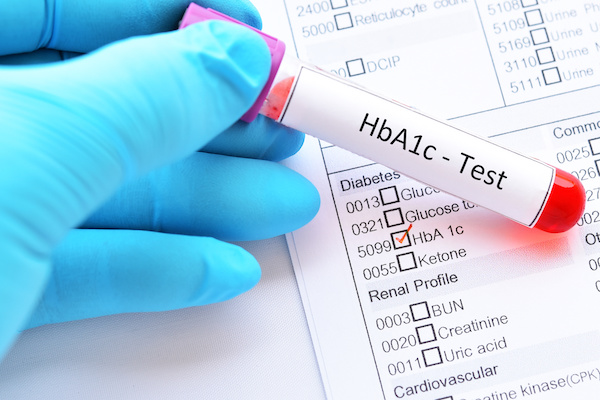
This article originally appeared in the January 2017 McDougall Newsletter and has been updated in October 2022.
By John McDougall, MD
Big Pharma and Big Medicine have faced many huge challenges over the past years to keep their cash cows—people with type-2 diabetes—each forking over an average of $16,752 annually (approximately 2.3 times more than what expenditures would be in the absence of diabetes). This financially rewarding system works well until the blood-sugar-lowering medicines, along with the gadgets and tests they rely on, are proven to be useless and dangerous. Unfortunately for the patients, industry fights back, defending their treasure-trove by hiring pricey medical experts, factoring in expected lawsuits, and exaggerating the benefits and minimizing the harms of their products.
One Right Does Not Compensate for So Many Wrongs
A modern medical miracle, the discovery of insulin in the early 20th century, has saved the lives of millions of people living with type-1 diabetes, a potentially deadly condition characterized by a severe lack of production of the hormone insulin by the pancreas. However, this innovative success cannot be translated into benefits for people with type-2 diabetes, those who produce, by means of their own pancreas, as much insulin, and oftentimes, twice as much insulin as a “normal” person. Because of the accumulation of excess body fat in people with type-2 diabetes, their tissues have become resistant to their own insulin and, therefore, their blood sugar rises.
Type-1 and type-2 diabetes are completely different diseases that happen to share the common sign of elevated blood sugar. Between these extremes is a spectrum called “type-one and a half (1.5) diabetes”. Patients with this intermediate condition produce enough insulin to stay well (meaning they avoid ketoacidosis and death) but not enough to maintain a normal blood sugar. People with type-1.5 and type-2 diabetes are also referred to as “non-insulin-dependant” (meaning they require no exogenous insulin).
Metformin Is Simply the Least Harmful
Metformin (Glucophage) has been commonly prescribed for over 60 years to lower blood sugar. More than half of the 58 million Medicare claims for medications to treat people with non-insulin-dependent diabetes in 2014 were for this class of oral medication. Almost all physicians these days practice under the belief that metformin is the first-line medication for diabetes because it not only lowers blood sugar but has multiple additional benefits, including fewer heart attacks and strokes (cardiovascular events) for the patient. However, the truth is that since 2001 the evidence supporting the cardiovascular benefits of diabetic medications has been recognized as seriously flawed. Furthermore, the universal claims that metformin reduces cardiovascular disease are primarily based on a small subgroup of patients (n = 342) from the 1998 United Kingdom Prospective Diabetes Study (UKPDS) conducted more than three decades ago.
Honest researchers have made multiple unsuccessful attempts to overturn dogma surrounding this “first-line medication” for diabetes. In 2012 researchers published an extensive review in the highly respected journal PLOS Medicine with this conclusion: “Although metformin is considered the gold standard, its benefit/risk ratio remains uncertain. We cannot exclude a 25% reduction or a 31% increase in all-cause mortality. We cannot exclude a 33% reduction or a 64% increase in cardiovascular mortality.” Cardiovascular in this case refers to disease of the large blood vessels (macrovascular disease), resulting in strokes and heart attacks.
The macrovascular benefits from diabetic medications is universally recognized to be untrue. As a result, the “sales pitch” has turned to “microvascular benefits,” those resulting in less damage to the small blood vessels of the eyes, kidneys, and nerves. Research strongly questions this claim. In the case of metformin, claims for microvascular benefits rest solely on the difference in one highly subjective measurement of eye damage, the need for retinal photocoagulation (a surgical technique using an intense beam of light).
Considering the lack of benefits, why has metformin become the drug of choice? Compared with other blood sugar-lowering medications, metformin’s popularity stems from the observation that it is one of the least harmful of the drugs commonly prescribed. Although useless, it does not induce hypoglycemia, weight gain, and heart failure like so many of the others.
| Diabetic Drugs | ||
| Class of Medication | Mechanism of Action | Some Special Harms from this Class |
| Biguanide: metformin (Glucophage) | Decreases hepatic glucose production | GI effects, lactic acidosis, vitamin B12 deficiency |
| Sulfonylureas: glimepiride, glipizide, glyburide | Increases secretion of insulin | Cardiac death, weight gain, hip fractures |
| GLP-1 Receptor agonists: albiglutide, dulaglutide, exenatide, liraglutide, lixisenatide | Increases secretion of insulin | kidney failure, pancreatitis, cancers |
| DPP-4 Inhibitors: alogliptin, linagliptin, saxagliptin, sitagliptin | Increases secretion of insulin | Pancreatitis, heart failure, fatal hepatic failure, joint pain |
| SGLT2 Inhibitors: canagliflozin, dapagliflozin, empagliflozin | Increases urinary loss of glucose | Fungal and bacterial urinary infections, kidney injury, leg and foot amputations |
| Meglitinides: nateglinide, repaglinide | Increases secretion of insulin | Weight gain, hypoglycemia |
| Thiazolidinediones: pioglitazone, rosiglitazone | Increases secretion of insulin | Heart faiure, weight gain, fractures, bladder cancer, hypoglycemia |
| Alpha-Glucosidase Inhibitors: acarbose, miglitol | Inhibits carbohydrate digestion | Abdominal pain, diarrhea, flatulence |
| Insulin (various forms) | Injects supplemental insulin | Weight gain, hypoglycemia |
Second-line Drugs Are More Toxic
Sulfonylureas, considered second-line therapy, account for about 30% of sales of diabetic medications. Since 1972 the Physicians’ Desk Reference (PDR)’s descriptions of every diabetic pill have included two paragraphs in heavy black print that begin with: “Special Warning on Increased Risk of Cardiovascular Mortality.”
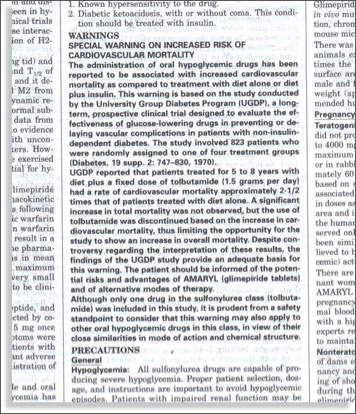
Another popular second-line diabetic medication, Avandia (rosiglitazone), was found in 2007 to decrease average blood sugar as measured by hemoglobin A1c by 1.5 %, but patients taking Avandia had 66 percent more heart attacks, 39 percent more strokes and 20 percent more deaths from cardiovascular-related problems. The manufacturer, GlaxoSmithKline, recently paid $3 billion to the FDA for its mischievous behavior; plus more than 50,000 Avandia lawsuits have been filed in state and federal courts across the US. But the market for this dangerous drug continues to rise simply because profits outweigh losses.
| Blood Glucose and HgBA1c |
| All agents used for the treatment of non-insulin-dependent diabetes are evaluated and approved for use based upon their efficacy in lowering blood glucose levels, with the safety and overall health benefits for the patients being largely ignored. Traditionally blood sugar levels are determined by use of a blood sugar metering device (glucometer). Normal fasting blood sugar is below 100 mg/dL (5.6 IU) This momentary measurement is most often performed by the patients at home.
Hemoglobin A1c (HgBA1c) is a long-term, laboratory-performed test used to estimate blood sugar levels over a previous two- to three-month period. Normal HgBA1c is considered less than 6% and levels can rise as high as 14%. [Link “Hemoglobin A1c” to: ] Most physicians consider—based on no meaningful scientific evidence—that the target level for treatment is between 7% and 8%. |
Aggressive Treatment Kills
Disappointing for pharmaceutical companies, physicians, and the 14% of the US population with diabetes, are the findings that “aggressive treatment” results in more weight gain; higher cholesterol, triglycerides, and/or blood pressure; and more heart disease, stroke, and/or death compared to less treatment. Aggressive treatments are often defined by target goals for HgBA1c of 6% compared to standard care results of about 8%.
| All Six Major Studies Show Harm from Aggressive Treatment |
| * The Diabetes Control and Complications Trial (DCCT) is one of the largest studies done to show the effects of drug therapy on diabetics. Six and a half years of treatment with intensive insulin therapy for type-1 diabetics resulted in more weight gain as well as higher cholesterol, LDL (bad) cholesterol, triglycerides, and blood pressure compared to people treated less aggressively. As expected from the rise in cholesterol, there was an increase in the risk of heart disease and stroke for the intensively treated patients.
* The Veterans Affairs Cooperative Study in Glycemic Control and Complications in NIDDM study showed an increase in cardiovascular events in those receiving intensive therapy. Diabetic patients with a history of a heart attack were studied, and those treated with insulin and/or other diabetic medications had an increased risk of death. * In the large European TRAndolapril Cardiac Evaluation (TRACE) study, investigators found diabetic patients with a history of heart attacks treated with insulin and/or other diabetic medications had almost twice the death rate as those diabetics treated with diet alone. Diabetics treated without medications (diet only) had the same death rate as people without diabetes. * The ACCORD study (Action to Control Cardiovascular Risk in Diabetes) showed that intensive treatment of diabetics increases the risk of dying compared to those patients treated less aggressively. On February 6, 2008 the National Heart, Lung, and Blood Institute (NHLBI) stopped the ACCORD study 17 months early because of adverse effects, including more death. Patients in the intensive-treatment group were oftentimes taking four shots of insulin and three pills daily, and checking their blood-sugar levels four times a day. * The ADVANCE (Action in Diabetes and Vascular Disease: Preterax and Diamicron Modified Release Controlled Evaluation) study found no reduction in heart attacks or strokes, deaths from cardiovascular causes, or death from any cause with intensive therapy. Hypoglycemia was more common, as always, for those people receiving more drugs. * The Veterans Affairs Diabetes Trial (VADT) found the intensive-therapy group reduced their hemoglobin A1c levels to 6.9% compared to 8.4% in the standard-therapy group. A weight gain of 18 pounds occurred with the intensive-treatment compared to 9 pounds with standard-therapy. There were 102 deaths from any cause in the intensive-therapy group and 95 in the standard-therapy group (sudden death was three times higher). |
FDA Encourages Safer and More Effective Treatments
Because of the undeniable and alarming results from standard therapy, in 2008 the US Food and Drug Administration (FDA) recommended that new diabetes drugs should have sufficient data from randomized trials to exclude an unacceptable increase in risk of major adverse cardiovascular events. (This was only a recommendation, not a requirement.) Drug companies responded quickly, enrolling thousands of patients in randomized clinical trials to examine the cardiovascular effects of newer diabetic (under patent, not generic) drugs. Three studies have, to date, been published on the benefits of newer classes of medications. The absolute reduction in death and/or heart disease was found to be much less than 3%, and the side effects reported are as serious as heart failure and damage to the eyes. Pharmaceutical companies, of course, funded all three studies.
The 3 Newest Trials Show Unacceptable Results
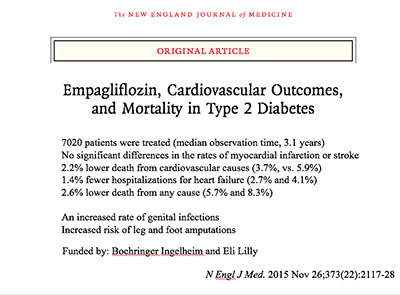
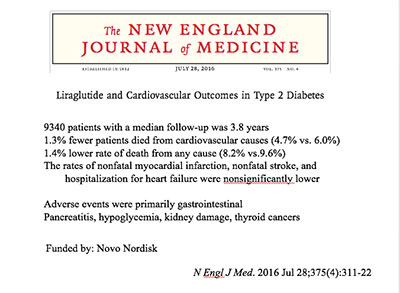
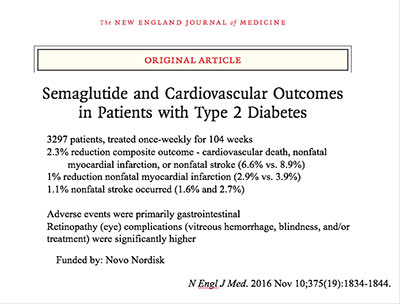
“State of the Art” in Medicine: Meters and Pumps
The treatment goal for diabetes is making numbers look better. One harmful consequence of this primary ambition has been the development of high-tech devices. Monitors worn by the patient continuously check blood sugars (Continuous Glucose Monitoring or CMG) as often as every five minutes. The CGM monitors themselves cost from $1,000 to $1,400. The sensors, which attach to the monitor, are only good for three to seven days, but they are expensive, too: $35 to $100 apiece. To add to the misery, the patient still must perform fingertip blood checks two to four times a day to keep the monitor calibrated. Often patients wear an additional device, called an insulin pump (costing more than $5,000) that responds to these signals and medicates the patient with offsetting doses of insulin. No health benefits have ever been demonstrated from attempts to meticulously control blood sugars by using this technology.
Monitors and pumps actually destroy the quality of peoples’ lives; not just of individual patient but of friends and family. Rather than a pleasant chat about the grandchildren over dinner, the conversation focuses on blood sugars, which are read as often as every five minutes, and insulin doses that follow. After all this expense, trouble, and turmoil there is only a 0.4% HgBA1c improvement in control by CGM over standard (glucose-finger-stick) monitoring.
How I Treat Diabetes
Diet is my fundamental treatment for diabetes. Using the proper diet, cure rates for type-2 diabetes approach 100% (with associated weight loss). Diet is also my fundamental treatment (including insulin) for type-1 diabetes. Diet prevents complications of kidney failure, heart disease, stroke, blindness, and premature death for type-1, type-1.5, type-2, and non-diabetic, patients.
People with type-1 diabetes must stay on insulin, but the administration of medication should be as unobtrusive as possible. Upon starting a healthy (McDougall) diet, the overall daily insulin dosage should be reduced by about 30% to help prevent hypoglycemia. Appropriate adjustments are made thereafter. Many people do well with one long-acting shot of insulin (like Lantus) in the evening. Others may find physical and psychological comfort by administrating additional short-acting insulin with meals. Too low a fasting blood sugar is below 150 mg/dL (8.3 IU) while on medication. Hypoglycemia causes disorientation, falls, and accidents.
Bariatric surgery is becoming a “treatment of choice” for people with obesity and type-2 diabetes. Short-term results demonstrate that approximately 80% of people (after weight loss) have been “cured.” However, these formerly obese people still suffer from poor health because they continue to eat the rich Western diet. Also because of this failure to improve their diets, many post-surgery patients regain their lost weight and their diabetes returns. The most effective and permanent way to cure obesity and type-2 diabetes is to adopt a low-fat, starch-based (McDougall) diet. This is the same diet that slows cancer growth, cleans out the arteries, loosens swollen painful joints, and moves bowels.
For type-2 diabetes I do not prescribe any diabetic medications. For type-1.5 diabetes I do prescribe long-acting insulin (Lantus) for these three reasons:
1) To decrease the rate of weight loss or to cause weight gain.
2) To relieve symptoms of diabetes, such as excessive thirst and urination.
3) To help relieve the worries of the patient over their high sugar numbers. Being treated with a little insulin makes patients, physicians, and families feel that “all of the bases are being covered.”
Recommended Articles
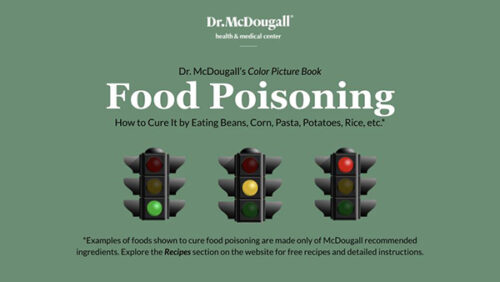
Dr. McDougall’s Color Picture Book: "Food Poisoning"

Making the Change to a Healthy Lifestyle Work






